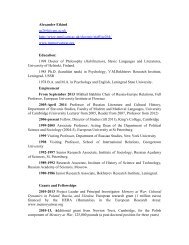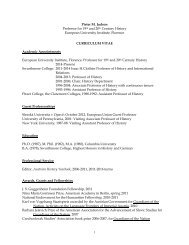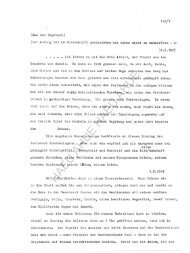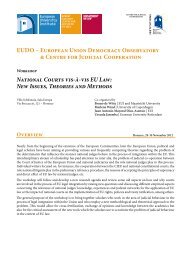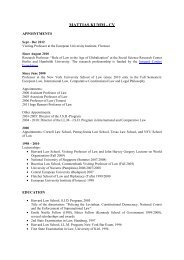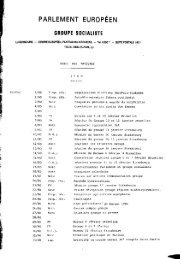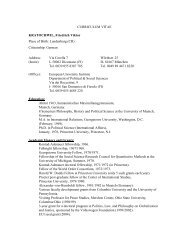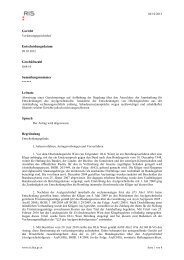Forecasting Large Datasets with Reduced Rank Multivariate Models
Forecasting Large Datasets with Reduced Rank Multivariate Models
Forecasting Large Datasets with Reduced Rank Multivariate Models
Create successful ePaper yourself
Turn your PDF publications into a flip-book with our unique Google optimized e-Paper software.
where:<br />
^ = ^ B[ + + 0 ~ 21 ( ~ 11 ) 1 ]; (18)<br />
= [ ~ 11 X 0 X + 2 IMr] 1 ; (19)<br />
and where ^ B is the OLS estimator, + is the generalized inverse of , 0 is column-wise<br />
orthogonal to + , and where ~ ij denotes the partitioning of ~ 1 = ([ + 0 ] 0 [ + 0 ]) 1<br />
into its …rst r and last N r rows and columns.<br />
Unconditional posterior distributions can be simulated by using a Gibbs sampling<br />
algorithm which draws in turn from (14), (17), and (13). 6 See Geweke (1996) for details.<br />
2.4 <strong>Reduced</strong> <strong>Rank</strong> BVAR Posterior (RRP)<br />
The BRR has the shortcoming of being computationally challenging when the assumed<br />
rank is high, as the estimation of this model requires simulation involving inversion<br />
of Mr -dimensional matrices. We propose a new method which retains the bene…t of<br />
rank reduction and shrinkage <strong>with</strong>out paying the high computational cost involved in<br />
the BRR. The method, which we label RRP (<strong>Reduced</strong> <strong>Rank</strong> Posterior) applies rank<br />
reduction on the posterior estimates of a Bayesian VAR and, as we shall see, it can<br />
produce substantial gains in forecast accuracy.<br />
The implementation of the method is straightforward. First, the system is estimated<br />
under the prior distribution described by equation (7), then a rank reduction is imposed<br />
as follows. Let B be the posterior mean of B and let B = U V be its singular value<br />
decomposition. Collecting the largest r singular values and associated vectors in the<br />
matrices = diag( 1; 2; :::; r); U = (u1; u2; :::; ur) and V = (v1; v2; :::; vr) a reduced<br />
rank approximation (of rank r) of the posterior mean is given by:<br />
which is our RRP estimator.<br />
B r = U V ; (20)<br />
6 In our application we draw 1100 draws, we drop the …rt 100 as burn in and then we keep each second<br />
draw to reduce the autocorrelation inherent to the MCMC scheme. This leaves us <strong>with</strong> a total of 500<br />
valid draws. Computation time (for producing one forecast) varies <strong>with</strong> the assumed rank of the system.<br />
The longest computation time is required by the system <strong>with</strong> rank r=10 and it takes about 4 minutes<br />
on a 3.33GHz Intel Core Duo processor.<br />
11




